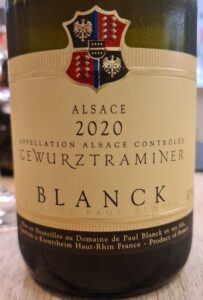Beautiful Gewurztraminer from Waitrose
 Really enjoyed finding this Gewurztraminer in Waitrose this week. Studying Alsace wines is fascinating. The area has such winemaking and grape growing history all of which contributes to the diverse styles and selection of grape varieties available from the area today. Add to that the region’s vast array of soil types, growing aspects and altitudes and you find that there is so much complexity from this relatively small growing region.
Really enjoyed finding this Gewurztraminer in Waitrose this week. Studying Alsace wines is fascinating. The area has such winemaking and grape growing history all of which contributes to the diverse styles and selection of grape varieties available from the area today. Add to that the region’s vast array of soil types, growing aspects and altitudes and you find that there is so much complexity from this relatively small growing region.
Alsace is geographically in an ideal location from which to export wine to a number of key neighbouring countries. Over the centuries it has also been influenced by the countries it borders. Perhaps its hero grape is Gewurztraminer but other noble varieties (as they are known) grown in Alsace can produce outstanding wines with beautiful acidity, complexity, length, and finish.
Gewurztraminer itself, is known to be typically floral and have a distinctive lychee characteristic, it is typically full bodied and surprisingly higher in alcohol than one might think.
Blanck family have a long history of wine making in Alsace dating back to the 1600’s, where they began farming in the Schlossberg area. Later generations were highly influential in gaining Grand Cru status for this area and at the same time extending their plantings to other areas of Alsace. They have held a long-standing commitment to Terroir based wine making and many family members are still involved in making the wines today.
The Gewurztraminer I found in Waitrose is made from grapes grown in Kientzheim. A vineyard they own with 20-year-old vines. The soil is a mix of clay and limestone which benefits from gentle, south-facing slopes as the altitude is actually relatively low at 400 metres for Alsace.
Grapes are typically hand harvested. Interestingly an air bag press is used to ensure extremely slow, gentle pressing which avoids crushing the stalks and pips whilst maintaining great extraction of those primary flavours associated with Gewurztraminer. Fermentation is undertaken with natural yeasts contributing to the winemaker’s desire for an expression of terroir. Fermentation usually lasts 4 to 6 weeks in stainless steel vats to control the temperature and ensure a reductive environment is maintained to preserve the aromatics of the grape variety. The wine is stored in oak for one year and lees aging is encouraged to add richness to the Gewurztraminer.
Here is my condensed WSET tasting note for this wine:
Appearance is pale lemon
The nose is pronounced with an immediate hit of lychee followed by blossom, rose, pear, peach, apricot, nectarine, mango, pineapple, turkish delight, cinnamon, honey and buttery cream.
The wine is dry with a medium minus acidity and medium alcohol, with a great flavour intensity of flavours echoing what I described on the nose. Perhaps the cream and fuller body from lees aging is more apparent to taste.
This wine is outstanding in quality. The alcohol and acid are in perfect balance. The wine’s flavours and aromas disguise the dry style of the wine extremely well and the lees aging adds a texture and fuller body to the wine. It has great complexity with many clusters of flavour. The wine’s finish is long and leaves the drinker thinking of that distinctive lychee note associated with Gewurztraminer. Fantastic!
